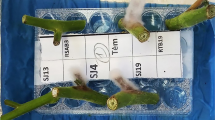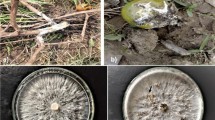Abstract
The aim of this study was to identify a Mexican native basidiomycete strain with antagonistic potential against phytopathogenic fungi. The antifungal activity of fifteen isolates against Fusarium oxysporum, Fusarium solani, Colletotrichum truncatum, Colletotrichum coccodes, Colletotrichum sp., Stemphylium solani, Botrytis cinerea, Epicoccum nigrum, Phomopsis sp. and Alternaria solani was studied in vitro using dual culture assay. An isolate of Macrolepiota sp (CS185) exhibited the strongest ability to compete on potato dextrose agar medium (PDA) causing 22.2 up to 46.6% inhibition in seven out of ten pathogens evaluated. The addition of 30% Macrolepiota sp. liquid filtrates (from 7 day-cultures in potato dextrose broth) to PDA plates inhibited 66% of A. solani growth. Application of Macrolepiota sp. CS185 culture fluids to control early blight disease caused in tomato plants by A. solani under greenhouse conditions diminished disease incidence and percent of damage. The length of the stems, the roots and the foliar area increased in the treated plants and, above all, the foliar symptoms decreased by 73%. Sesquiterpene lactones and quinones identified in culture fluids might be responsible for Macrolepiota antifungal activity. This study proves that Macrolepiota sp. CS185 culture filtrates have potential in biocontrol of early blight disease.
Zusammenfassung
Ziel dieser Studie war es, einen in Mexiko heimischen Basidiomycetenstamm mit antagonistischem Potenzial gegen phytopathogene Pilze zu identifizieren. Die antimykotische Aktivität von fünfzehn Isolaten gegen Fusarium oxysporum, Fusarium solani, Colletotrichum truncatum, Colletotrichum coccodes, Colletotrichum sp., Stemphylium solani, Botrytis cinerea, Epicoccum nigrum, Phomopsis sp., und Alternaria solani wurde in vitro unter Verwendung eines Doppelkulturassays untersucht. Ein Isolat von Macrolepiota sp. (CS185) zeigte die stärkste Konkurrenzfähigkeit auf dem Kartoffeldextrose‐Agar‐Medium (PDA), was bei sieben von zehn untersuchten Krankheitserregern zu einer Hemmung von 22,2 bis 46,6 % führte. Die Zugabe von 30 % Macrolepiota sp.-Flüssigfiltrat (aus 7‑Tage-Kulturen in Kartoffeldextrose-Saft) zu PDA-Platten hemmte das Wachstum von A. solani um 66 %. Die Anwendung von Macrolepiota sp. CS185-Kulturflüssigkeiten zur Bekämpfung der durch A. solani unter Gewächshausbedingungen verursachten Dürrfleckenkrankheit bei Tomatenpflanzen verringerte die Häufigkeit und den prozentualen Anteil der Schäden. Die Länge der Stiele, der Wurzeln und der Blattfläche nahm bei den behandelten Pflanzen zu, die Blattsymptome nahmen um 73 % ab. In Kulturflüssigkeiten identifizierte Sesquiterpenlaktone und Chinone könnten für die antimykotische Aktivität von Macrolepiota verantwortlich sein. Diese Studie belegt, dass Macrolepiota sp. CS185-Kulturfiltrate Potenzial zur biologischen Kontrolle der Dürrfleckenkrankheit besitzen.

Similar content being viewed by others
References
Abo-Elyous KA, Abdel-Hafez SI, Abdel-Rahim IR (2014) Isolation of Trichoderma and evaluation of their antagonistic potential against Alternaria porri. J Phytopathol 162(9):567–574. https://doi.org/10.1111/jph.12228
Alves MJ, Ferreira IC, Dias J, Teixeira V, Martins A, Pintado M (2013) A review on antifungal activity of mushroom (basidiomycetes) extracts and isolated compounds. Curr Top Med Chem 13:2648–2659. https://doi.org/10.2174/15680266113136660191
Astegiano ED, Favaro JC, Bouzo CA (2001) Estimación del área foliar en distintos cultivares de tomate (Lycopersicon esculentum Mill.) utilizando medidas foliares lineales. Investig Agrar Prod Prot Veg 16(2):249–256
Baka ZAM (2014) Biological control of the predominant seed-borne fungi of tomato by using plant extracts. J Phytopathol Pest Manag 1:10–22
Barneche S, Jorcin G, Cecchetto G, Cerdeiras MP, Vázquez A, Alborés S (2016) Screening for antimicrobial activity of wood rotting higher basidiomycetes mushrooms from Uruguay against phytopathogens. Int J Med Mushrooms 18:261–267. https://doi.org/10.1615/IntJMedMushrooms.v18.i3.90
Barseghyan GS, Barazani A, Wasser SP (2016) Medicinal mushrooms with anti-phytopathogenic and insecticidal properties. Mushroom Biotechnol. https://doi.org/10.1016/B978-0-12-802794-3.00008-4
Bergougnoux V (2014) The history of tomato: from domestication to bio pharming. Biotechnol Adv 32(1):170–189. https://doi.org/10.1016/j.biotechadv.2013.11.003
Coy Barrera CA, Parra J, Cuca Suárez LE (2014) Caracterización química del aceite esencial e identificación preliminar de metabolitos secundarios en hojas de la especie raputia heptaphylla (rutaceae). Elementos 4(4):31–39
Dias MP, Bastos MS, Xavier VB, Cassel E, Astarita LV, Santarém ER (2017) Plant growth and resistance promoted by Streptomyces spp. in tomato. Plant Physiol Biochem 118:479–493. https://doi.org/10.1016/j.plaphy.2017.07.017
Duarte Y, Pino O, Infante D, Sánchez Y, Travieso MD, Martínez B (2013) Efecto in vitro de aceites esenciales sobre Alternaria solani Sorauer. Rev Prot Veg 28(1):54–59
Fontenelle AD, Guzzo SD, Lucon CM, Harakava R (2011) Growth promotion and induction of resistance in tomato plant against Xanthomonas euvesicatoria and Alternaria solani by Trichoderma spp. Crop Prot 30(11):1492–1500. https://doi.org/10.1016/j.cropro.2011.07.019
Gao Z, Zhang B, Liu H, Han J, Zhang Y (2017) Identification of endophytic Bacillus velezensis ZSY‑1 strain and antifungal activity of its volatile compounds against Alternaria solani and Botrytis cinerea. Biol Control 105:27–39. https://doi.org/10.1016/j.biocontrol.2016.11.007
Ghazanfar MU, Raza W, Ahmed KS, Qamar J, Haider N, Rasheed MH (2016) Evaluation of different fungicides against Alternaria solani (Ellis & Martin) Sorauer cause of early blight of tomato under laboratory conditions. Int J Zool Stud 1(5):8–12
Gjhorbanpour M, Omidvari M, Abbaszadeh-Dahaji P, Omidvar R, Kariman K (2018) Mechanisms underlying the protective effects of beneficial fungi against plant diseases. Biol Control 117:147–157. https://doi.org/10.1016/j.biocontrol.2017.11.006
Imtiaj A, Lee TS (2007) Screening of antibacterial and antifungal activities from Korean wild mushrooms. World J Agric Sci 3(3):316–321
Innocenti G, Garibyan NG, Badalyan SM (2002) Antagonistic activity of xylotrophic mushrooms against pathogenic fungi of cereals in dual culture. Phytopathol Mediterr 41(3):220–225
Jorcin G, Barneche S, Vázquez A, Cerdeiras MP, Alborés S (2017) Effects of culture conditions on antimicrobial activity of Ganoderma resinaceum (Agaricomycetes) extracts. Int J Med Mushrooms 19(8):737–744. https://doi.org/10.1615/IntJMedMushrooms.2017021217
Joseph A, Igbinosa OB, Alori ET, Ademiluyi BO, Aluko AP (2017) Effectiveness of Pseudomonas species in the management of tomato early blight pathogen Alternaria solani. Afr J Microbiol Res 11(23):972–976. https://doi.org/10.5897/AJMR2017.8564
Kim KH, Park KM, Choi SU, Lee KR (2009) Macrolepiotin, a new indole alkaloid from Macrolepiota neomastoidea. J Antibiot 62(6):335–338. https://doi.org/10.1038/ja.2009.30
Klančnik A, Megušar P, Sterniša M, Jeršek B, Bucar F, Smole Možina S, Kos J, Sabotič J (2017) Aqueous extracts of wild mushrooms show antimicrobial and antiadhesion activities against bacteria and fungi. Phytother Res 31(12):1971–1976. https://doi.org/10.1002/ptr.5934
Kosanić M, Ranković B, Rancić A, Stanojković T (2016) Evaluation of metal concentration and antioxidant, antimicrobial, and anticancer potentials of two edible mushrooms Lactarius deliciosus and Macrolepiota procera. J Food Drug Anal 24(3):477–484. https://doi.org/10.1016/j.jfda.2016.01.008
Kumar N, Bhardwaj ML, Kumari S, Sharma A, Kansal S (2018) Screening of tomato (Solanum lycopersicum L.) germplasm for growth, yield, resistance against buckeye rot and Alternaria blight severity under mid-hills conditions of Himachal Pradesh. J Pharmacogn Phytochem 7(1):2098–2103
Llauradó G, Morris HJ, Ferrera L, Camacho M, Castán L, Lebeque Y, Beltrán Y, Cos P, Bermúdez RC (2015) In-vitro antimicrobial activity and complement/macrophage stimulating effects of a hot-water extract from mycelium of the oyster mushroom Pleurotus sp. Innov Food Sci Emerg Technol 30:177–183. https://doi.org/10.1016/j.ifset.2015.05.002
Luo DQ, Shao HJ, Zhu HJ, Liu JK (2005) Activity in vitro and in vivo against plant pathogenic fungi of grifolin isolated from the basidiomycete Albatrellus dispansus. Z Naturforsch C 60(1/2):50–56. https://doi.org/10.1515/znc-2005-1-210
Mohan V, Nivea R, Menon S (2015) Evaluation of ectomycorrhizal fungi as potential bio-control agents against selected plant pathogenic fungi. J Acad Ind Res 3(9):408–412
Muthomi JW, Lengai GM, Wagacha MJ, Narla RD (2017) In vitro activity of plant extracts against some important plant pathogenic fungi of tomato. Aust J Crop Sci 11(6):683–689. https://doi.org/10.21475/ajcs.17.11.06.p399
Oka K, Ishihara A, Sakaguchi N, Nishino S, Parada RY, Nakagiri A, Otani H (2015) Antifungal activity of volatile compounds produced by an edible mushroom Hypsizygus marmoreus against phytopathogenic fungi. J Phytopathol 163(11/12):987–996. https://doi.org/10.1111/jph.12405
Oliva J, Messal M, Wendt L, Elfstrand M (2017) Quantitative interactions between the biocontrol fungus Phlebiopsis gigantea, the forest pathogen Heterobasidion annosum and the fungal community inhabiting Norway spruce stumps. For Ecol Manag 402:253–264. https://doi.org/10.1016/j.foreco.2017.07.046
Owaid MN, Al Saeedi SSS, Abed IA, Shahbazi P, Sabaratnam V (2016) Antifungal activities of some Pleurotus species (higher basidiomycetes). Walailak J Sci Tech 14(3):215–224
Paramanandham P, Rajkumari J, Pattnaik S, Busi S (2017) Biocontrol potential against Fusarium oxysporum f. sp. lycopersici and Alternaria solani and tomato plant growth due to plant growth—promoting Rhizobacteria. Int J Veg Sci 23(4):294–303. https://doi.org/10.1080/19315260.2016.1271850
Pereira E, Santos A, Reis F, Tavares RM, Baptista P, Lino-Neto T, Almeida-Aguiar C (2013) A new effective assay to detect antimicrobial activity of filamentous fungi. Microbiol Res 168(1):1–5. https://doi.org/10.1016/j.micres.2012.06.008
Petre CV, Dîrțu AC, Niculaua M, Tănase C (2017) Volatile compounds in the aroma of three species of wood-rotting basidiomycetes and their antifungal potential. J Plant Dev 24:73–83
Prajapati HN, Panchal RK, Patel ST (2014) Efficacy of bioagents and biological interaction of Alternaria solani with phylloplane mycoflora of tomato. J Mycopathol Res 52(1):81–86
Qi QY, Bao L, Ren JW, Han JJ, Zhang ZY, Li Y, Yao YJ, Cao R, Liu HW (2014) Sterhirsutins A and B, two new heterodimeric sesquiterpenes with a new skeleton from the culture of Stereum hirsutum collected in Tibet Plateau. Org Lett 16(19):5092–5095. https://doi.org/10.1021/ol502441n
Radhajeyalakshmi R, Velazhahan R, Prakasam V (2012) In vitro evaluation of solvent extracted compounds from edible macromycetes against phytopathogenic fungi. Arch Phytopathol Plant Prot 45(3):293–300. https://doi.org/10.1080/03235408.2011.559048
Ramos-Sandoval RU, Gutiérrez-Soto JG, Rodríguez-Guerra R, Salcedo-Martínez SM, Hernández-Luna CE, Luna-Olvera HA, Jiménez-Bremont JF, Fraire-Velázquez S, León A, Humberto I (2010) Antagonismo de dos ascomicetos contra Phytophthora capsici Leonian, causante de la marchitez del chile (Capsicum annuum L.). Rev Mex Fitopatol 28(2):75–86
Robles CA, Ceriani-Nakamurakare E, Slodowicz M, González-Audino P, Carmarán CC (2018) Granulobasidium vellereum (Ellis &Cragin) Jülich, a promising biological control agent. Biol Control 117:99–108. https://doi.org/10.1016/j.biocontrol.2017.10.012
Sarkar S, Beura SK, Nandi A, Das S, Dash SK, Senapati N, Pandey G, Patnaik A (2016) Management of Early blight of tomato (Alternaria solani Ellis and Martin) by chemicals and biocontrol agents under field condition. J Mycopathol Res 54(1):81–84. https://www.cabdirect.org/cabdirect/abstract/20163253747
Schüffler A (2018) Secondary metabolites of basidiomycetes. In: Physiology and Genetics. Springer, Cham, pp 231–275
Senatore F (1988) Chemical constituents of some species of Agaricaceae. Biochem Syst Ecol 16(7/8):601–604. https://doi.org/10.1016/0305-1978(88)90070-1
Shen JW, Ma BJ, Li W, Yu HY, Wu TT, Ruan Y (2009) Activity of armillarisin B in vitro against plant pathogenic fungi. Z Naturforsch C 64(11/12):790–792. https://doi.org/10.1515/znc-2009-11-1206
Sivanandhan S, Khusro A, Paulraj MG, Ignacimuthu S, AL-Dhabi NA (2017) Biocontrol properties of basidiomycetes: an overview. J Fungi 3(1):2. https://doi.org/10.3390/jof3010002
Survilienë E (2002) Reaction of micromycetes to antagonistic organisms and fungicides in substrate. Biologija 1:14–17
Tonucci-Zanardo NM, Pascholati SF, Di Piero RM (2015) In vitro antimicrobial activity of aqueous extracts from Lentinula edodes isolates against Colletotrichum sublineolum and Xanthomonas axonopodis pv. Passiflorae. Summa Phytopathol 4(1):13–20. https://doi.org/10.1590/0100-5405/1995
Vahidi H, Kobarfard F, Namjoyan F (2004) Effect of cultivation conditions on growth and antifungal activity of Mycena leptocephala. Afr J Biotechnol 3(11):606–609
Varma PK, Gandhi SK, Surender S (2008) Biological control of Alternaria solani, the causal agent of early blight of tomato. J Biol Control 22(1):67–72
Verma A, Kumar S, Shina HA, Jaiswal S (2018) Evaluate the efficacy of bio-control agents and botanicals against early blight of potato caused by Alternaria solani. Pharma Innov J 7(3):28–30
Ying WU, Lu-dan HO, Jie ZH (2016) Inhibitory effects of metabolites from eight strains of Bacillus, Aspergillus, and Streptomyces on Alternaria solani. Jiangsu J Agric Sci 2:9
Author information
Authors and Affiliations
Corresponding author
Ethics declarations
Conflict of interest
J.S. Hernández-Ochoa, L.N. Levin, C.E. Hernández-Luna, J.F. Contreras-Cordero, G. Niño-Medina, A. Chávez-Montes, I. López-Sandin and G. Gutiérrez-Soto declare that they have no competing interests.
Rights and permissions
About this article
Cite this article
Hernández-Ochoa, J.S., Levin, L.N., Hernández-Luna, C.E. et al. Antagonistic Potential of Macrolepiota sp. Against Alternaria Solani as Causal Agent of Early Blight Disease in Tomato Plants. Gesunde Pflanzen 72, 69–76 (2020). https://doi.org/10.1007/s10343-019-00484-4
Received:
Accepted:
Published:
Issue Date:
DOI: https://doi.org/10.1007/s10343-019-00484-4




